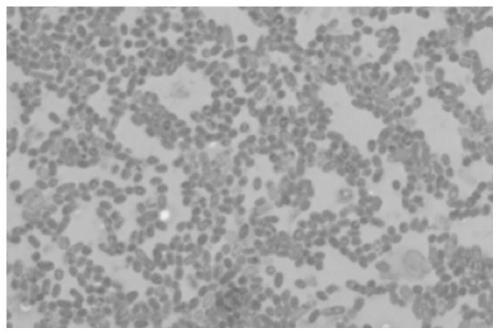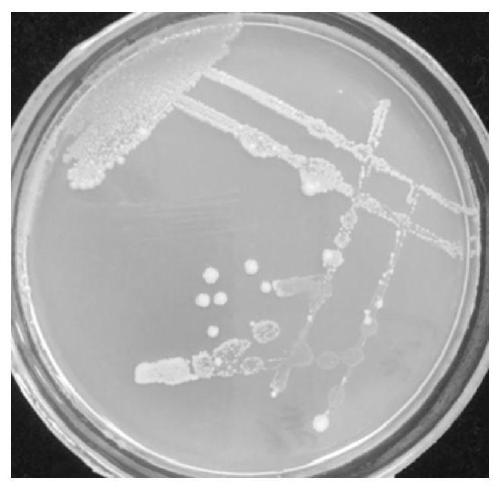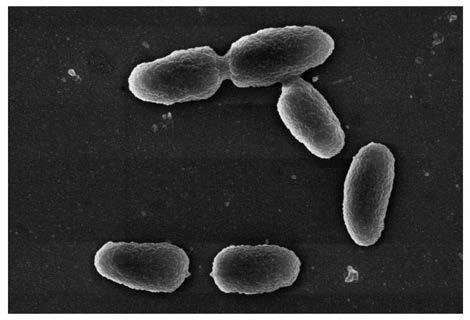Vibrio natriegens and application thereof
A technology of sodium vibrio and alginate lyase, applied in the field of microorganisms
- Summary
- Abstract
- Description
- Claims
- Application Information
AI Technical Summary
Problems solved by technology
Method used
Image
Examples
Embodiment 1
[0030] The screening method of embodiment 1 sodium vibrio Vibrio natriegens
[0031] (1) The sea mud was sampled near the kelp breeding factory in Rongcheng City, Shandong Province, and 1g of the sample was taken and dispersed evenly in 50mL of sterile water.
[0032] (2) Inoculate 1 mL of supernatant into 50 mL of screening liquid medium, culture at 28°C and 200 rpm for 2 days, and dilute 10 -6 And spread it on the screening plate medium, culture at 28°C for 2 days, pick single colonies of different shapes and streak the plates several times to obtain pure cultures.
[0033] (3) Pick single colonies of different forms, inoculate them in liquid medium, and culture them at 28°C and 200rpm for 2 days, take the supernatant to measure the enzyme activity of the strain, select a strain with higher enzyme activity, and entrust the China Center for Typical Culture Collection to preserve it. The morphological characteristics, physiological and biochemical characteristics and 16S rDNA...
Embodiment 2
[0034] The identification of embodiment 2 sodium vibrio Vibrio natriegens
[0035] (1) Plate colony morphology
[0036] Such as figure 2 As shown, the plate colony morphology of sodium vibrio SK42.001: Stretch on the plate medium to grow rapidly, and grow a single colony after 24 hours of culture at 28°C. The colony is round and convex, milky white, moist and slightly sticky, and smooth , with flat edges and a diameter of about 0.6-0.8cm.
[0037] (2) The characteristics of the bacteria under the electron microscope
[0038] Such as image 3 As shown, the cell characteristics of the sodium vibrio SK42.001 under the electron microscope: the cell is short, with blunt rounded ends, curved into an arc shape, and the size is 0.6-0.8 μm×1.2-1.4 μm.
[0039] (3) Physiological and biochemical characteristics
[0040] Physiological and biochemical characteristics of sodium vibrio SK42.001: such as figure 1 , Table 1, and Table 2 show that Narophilic Vibrio is Gram-staining negat...
Embodiment 3
[0050] The feasibility of embodiment 3 sodium vibrio Vibrio natriegens as novel model organism
[0051] (1) Measurement of growth rate
[0052] In LB3 liquid medium (NaCl concentration is the LB medium of 3%), it is 16.2min when cultivating generation, while it is 31.4min when referring to bacterial strain E.coli BL21 generation ( Figure 4 ); SK42.001 grew a single colony after 5 hours of streak culture on the LB plate, while E.coli BL21 required 10 hours. It shows that SK42.001 grows rapidly, which is about twice that of E.coli.
[0053] (2) Feasibility of SK42.001 expressing foreign genes
[0054] The broad host plasmid pAWP89 was selected to construct a recombinant plasmid pAWP89-GFP-Cm containing a green fluorescent protein (GFP) reporter gene and a chloramphenicol (Cm) resistance gene selection marker ( Figure 5 ), using the pRK2013 helper plasmid, pAWP89-GFP-Cm was introduced into SK42.001 through triparental conjugation, and the conjugated SK42.001 recombinant bact...
PUM
 Login to View More
Login to View More Abstract
Description
Claims
Application Information
 Login to View More
Login to View More - R&D
- Intellectual Property
- Life Sciences
- Materials
- Tech Scout
- Unparalleled Data Quality
- Higher Quality Content
- 60% Fewer Hallucinations
Browse by: Latest US Patents, China's latest patents, Technical Efficacy Thesaurus, Application Domain, Technology Topic, Popular Technical Reports.
© 2025 PatSnap. All rights reserved.Legal|Privacy policy|Modern Slavery Act Transparency Statement|Sitemap|About US| Contact US: help@patsnap.com



